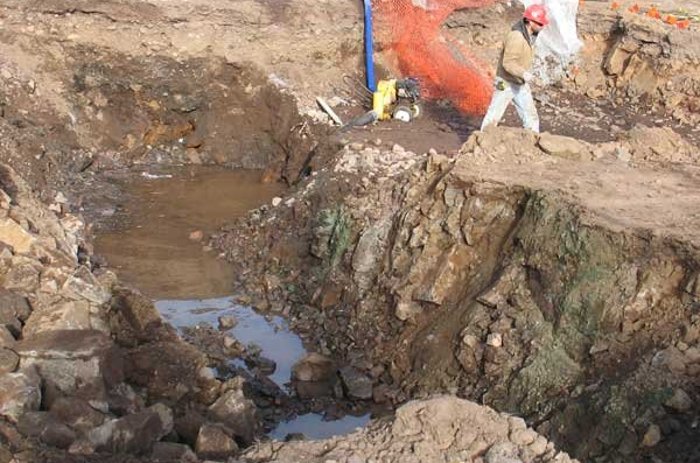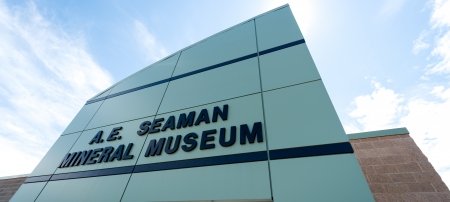Museum Will Live on Top of Mabbs Mine Shaft

The irony of an old mine shaft being discovered during the construction of a new mineral museum building is not lost on Ted Bornhorst.
Bornhorst is director of the A. E. Seaman Mineral Museum, whose new building will straddle the old shaft. With the help of the Michigan Tech Archives, the professor of economic and engineering geology at Michigan Technological University has been able to trace historical references to the shaft as far back as the 1860s, when it began its short lifespan.
Actually, there are four shafts, ranging in depth from 80 to 200 feet, near the construction site of the new building for the museum that will sit on the southern edge of the Michigan Tech campus, adjacent to the Advanced Technology Development Complex.
Construction crews from Moyle Construction made the discovery of the main shaft, and Michigan Tech facilities management personnel have capped it, using some 700 tons of concrete.
“The guys worked late, plugging the holes,” said Mike Wilmers, project manager with facilities management at Tech. “We put a couple of feet of concrete on top of it and will add another four feet on top of that.”
Although some thought it would be nice to save a shaft as part of the museum grounds, it just wasn’t feasible, according to Wilmers.
Some previous research by Tech students over the years acknowledged the shaft’s presence,
but it was not well known, according to Bornhorst.
“It was the Mabbs vein, named after brothers John and Austin, and it resided within
the boundaries of the old Isle Royale Mining Company, the first near Portage Lake,”
Bornhorst says.
According to his sources, a vertically standing single mass of copper weighing 2,300 pounds was taken out 70 feet below what was the main “F” shaft in 1865.
“The Mabbs lode was a tabular vein, about five feet wide and cutting across the host rocks, comprising a cluster of small seams up to five inches thick, rather than a single, well-defined vein,” Bornhorst says.
Large amounts of water infiltrating the mine made mining difficult, but the F shaft reached down 160 feet, with drifts driven north and south, within one year, according to Bornhorst. The F shaft soon produced nearly 24,000 pounds of copper, but still wasn’t making money.
“Despite John Mabbs’ objection, the company shut down the unprofitable mining operations at the Mabbs vein a year later,” Bornhorst says. Although mining was resumed later by the Mabbs brothers, and they raised another one-ton slab, the shaft ended operations by the 1870s.
The Mabbs continued working with the Isle Royale Mining Company (so named because it was originally going to mine the island, not Houghton County properties).
The ironies continue.
In 1866, Austin Mabbs was among the founders of the Houghton County Historical Society and Mining Institute.
“It is indeed fitting that a vein named after the Mabbs brothers now has a mineral museum linked to it,” Bornhorst adds, noting that Moyle Construction secured several small specimens of native copper from the mine to add to the museum’s collections.
The Mabbs are credited with bringing various mining technologies to the Keweenaw and the world, including an early power drill, according to Bornhorst. They also attempted to bring nitroglycerin to the area, but they were threatened to be “ridden out of town on a rail,” according to newspaper accounts of the day.
“After more than 125 years out of sight, the Mabbs brothers are once again, and will be for years to come, a visible part of Copper Country history,” Bornhorst says. “The brothers were risk-taking entrepreneurs, innovators and preservers of history, qualities exemplified by Michigan Tech students since its founding.”
Michigan Technological University is an R1 public research university founded in 1885 in Houghton, and is home to nearly 7,500 students from more than 60 countries around the world. Consistently ranked among the best universities in the country for return on investment, Michigan's flagship technological university offers more than 185 undergraduate and graduate degree programs in science and technology, engineering, computing, forestry, business, health professions, humanities, mathematics, social sciences, and the arts. The rural campus is situated just miles from Lake Superior in Michigan's Upper Peninsula, offering year-round opportunities for outdoor adventure.




Comments